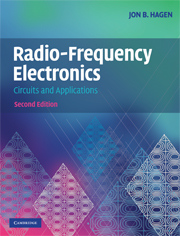Book contents
- Frontmatter
- Contents
- Preface
- 1 Introduction
- 2 Impedance matching
- 3 Linear power amplifiers
- 4 Basic filters
- 5 Frequency converters
- 6 Amplitude and frequency modulation
- 7 Radio receivers
- 8 Suppressed-carrier AM and quadrature AM (QAM)
- 9 Class-C, D, and E Power RF amplifiers
- 10 Transmission lines
- 11 Oscillators
- 12 Phase lock loops and synthesizers
- 13 Coupled-resonator bandpass filters
- 14 Transformers and baluns
- 15 Hybrid couplers
- 16 Waveguide circuits
- 17 Small-signal RF amplifiers
- 18 Demodulators and detectors
- 19 Television systems
- 20 Antennas and radio wave propagation
- 21 Radar
- 22 Digital modulation techniques
- 23 Modulation, noise, and information
- 24 Amplifier and oscillator noise analysis
- 25 The GPS Navigation system
- 26 Radio and radar astronomy
- 27 Radio spectrometry
- 28 S-parameter circuit analysis
- 29 Power supplies
- 30 RF test equipment
- Index
- References
21 - Radar
Published online by Cambridge University Press: 05 June 2012
- Frontmatter
- Contents
- Preface
- 1 Introduction
- 2 Impedance matching
- 3 Linear power amplifiers
- 4 Basic filters
- 5 Frequency converters
- 6 Amplitude and frequency modulation
- 7 Radio receivers
- 8 Suppressed-carrier AM and quadrature AM (QAM)
- 9 Class-C, D, and E Power RF amplifiers
- 10 Transmission lines
- 11 Oscillators
- 12 Phase lock loops and synthesizers
- 13 Coupled-resonator bandpass filters
- 14 Transformers and baluns
- 15 Hybrid couplers
- 16 Waveguide circuits
- 17 Small-signal RF amplifiers
- 18 Demodulators and detectors
- 19 Television systems
- 20 Antennas and radio wave propagation
- 21 Radar
- 22 Digital modulation techniques
- 23 Modulation, noise, and information
- 24 Amplifier and oscillator noise analysis
- 25 The GPS Navigation system
- 26 Radio and radar astronomy
- 27 Radio spectrometry
- 28 S-parameter circuit analysis
- 29 Power supplies
- 30 RF test equipment
- Index
- References
Summary
The idea that radio waves could be used to detect the presence of stationary or moving objects emerged around 1900, almost as soon as radio itself. Christian Hueslmeyer, a German inventor, demonstrated an apparatus in 1904 which, when mounted on a bridge above the Rhine, rang a bell when a ship passed beneath. He used a (now) primitive spark gap RF source and coherer detector. The system may have shown only marginal potential for collision avoidance, as the German Navy demonstrated no interest. Sir Robert Watson-Watt developed meteorological radar in Britain in the 1930s and then a chain of air defense radars during World War II. In the U.S., the MIT Radiation Laboratory, set up to develop military microwave radar systems, had nearly 4000 employees between 1940 and 1945. The acronym RADAR, for Radio Detection And Ranging, has been attributed to U.S. Navy officers F. R. Furth and S. M. Tucker, who introduced it in 1940, though the term remained classified throughout the war.
Today, radar goes beyond aircraft tracking to applications as diverse as space object monitoring, storm tracking, detection of clear air turbulence, and velocity measurements of speeding automobiles and baseballs. In this chapter, we look at some commonly used radars, some general system aspects of radar, and, finally, some RF components and techniques developed specifically for radar.
Some representative radar systems
Classic surveillance radar
Figure 21.1 is a block diagram of the classic radar system used to monitor air traffic.
- Type
- Chapter
- Information
- Radio-Frequency ElectronicsCircuits and Applications, pp. 278 - 299Publisher: Cambridge University PressPrint publication year: 2009



